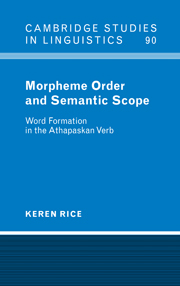Book contents
- Frontmatter
- Contents
- Preface
- 1 Introduction: Beginning the Journey
- PART I FIRST STEPS
- PART II THE LEXICAL ITEMS
- PART III THE FUNCTIONAL ITEMS
- 9 An Introduction to the Functional Elements
- 10 Pronominals
- 11 The Aspect System
- 12 Qualifiers and Their Ordering
- 13 On the Ordering of Functional Items
- PART IV A VIEW OF THE LEXICON
- PART V THE END OF THE JOURNEY
- PART VI APPENDIXES
- Notes
- References
- Name Index
- Languages Index
- Subject Index
13 - On the Ordering of Functional Items
Published online by Cambridge University Press: 06 July 2010
- Frontmatter
- Contents
- Preface
- 1 Introduction: Beginning the Journey
- PART I FIRST STEPS
- PART II THE LEXICAL ITEMS
- PART III THE FUNCTIONAL ITEMS
- 9 An Introduction to the Functional Elements
- 10 Pronominals
- 11 The Aspect System
- 12 Qualifiers and Their Ordering
- 13 On the Ordering of Functional Items
- PART IV A VIEW OF THE LEXICON
- PART V THE END OF THE JOURNEY
- PART VI APPENDIXES
- Notes
- References
- Name Index
- Languages Index
- Subject Index
Summary
In this chapter I examine the ordering of material within the functional complex. In all of the Athapaskan languages except Hupa and Kato (see chapter 10), object pronominals systematically precede number subjects and aspectual material, be it subsituation aspect, situation aspect, or viewpoint aspect. Qualifiers are generally sandwiched between number subjects and aspect. Finally, first and second person subjects appear at the right edge, to the right of aspect. The basic schema is shown in (1).
(1) object – number subject – qualifiers – aspect – 1/2 subject
This schema is simplified, with much omitted. Recall that in chapter 10 I argued that the ordering of subjects and objects in general is not surprising. I am concerned in this chapter with ordering among positions; see chapters 10–12 for discussion of ordering within each position.
In this chapter I argue that the overall ordering in (1) is consistent with the scope hypothesis. Scope predicts some fixed orderings, such as objects appearing to the left of situation aspect, and also allows for some variable orderings.
The Ordering of Objects and Situation Aspect
Background
One striking fixed ordering across the languages involves objects and situation aspect – this is the only possible ordering across the family. Objects are consistently at the left edge of the functional complex (with the exception of Hupa and Kato; see chapter 10).
- Type
- Chapter
- Information
- Morpheme Order and Semantic ScopeWord Formation in the Athapaskan Verb, pp. 342 - 366Publisher: Cambridge University PressPrint publication year: 2000



